|
 Ancient Lenses:
(Optical Lenses)
Ancient Lenses:
(Optical Lenses)
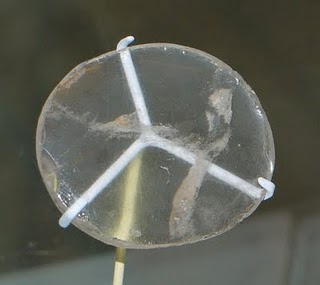 The Nimrud lens: Whatever its origin, as
ornament, as magnifying lens or part of a telescope, the Nimrud
lens is the oldest lens in the world. Looking at it evokes
mystery and wonder. It can be seen in room 55 of the British
Museum, in case 9 of the Lower Mesopotamian Gallery. However
unusual this object seems at first, it is not unique. In fact
there are several hundred reported lenses now on record from
around the ancient world. The Nimrud lens: Whatever its origin, as
ornament, as magnifying lens or part of a telescope, the Nimrud
lens is the oldest lens in the world. Looking at it evokes
mystery and wonder. It can be seen in room 55 of the British
Museum, in case 9 of the Lower Mesopotamian Gallery. However
unusual this object seems at first, it is not unique. In fact
there are several hundred reported lenses now on record from
around the ancient world.
To date, the earliest lenses
identified in context are from the IV/V Dynasties of Egypt,
dating back to about 4,500 years ago (e.g., the superb `Le
Scribe Accroupi' and `the Kai' in the Louvre; added fine
examples are located in the Cairo Museum). Latter examples have
been found in Knossos (Minoan [Herakleion Museum]; ca. 3,500
years ago) (6)
It may not be unique. Another, possibly 5th
century BC, lens was found in a sacred cave on Mount Ida on
Crete. It was more powerful and of far better quality than the
Nimrud lens.
Also, Roman writers Pliny and Seneca refer to
a lens used by an engraver in Pompeii. So perhaps the ancients
knew more about lenses than we give them credit for.
(1)
(It only takes two lenses together in a
tube and you have a telescope)
Quote from Robert
Temple 'Forbidden Technology', 2009:
'I have found in
museums all over the world, more than 450 ancient optical
artefacts, most of them lenses, but in any case, magnifying
aids.
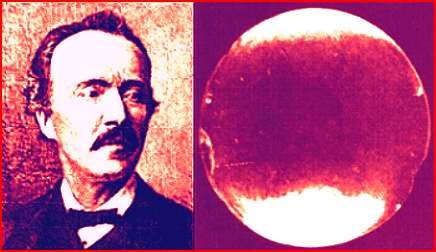 These
ancient lenses generally magnify about 1.5 or 2 times. Heinrich
Schliemann (left), the 19th century discoverer of Troy,
excavated 48 rock crystal lenses at Troy. This is one of the
largest hoards of ancient lenses ever found. These were
unfortunately lost for many decades because they were with the
missing Trojan gold hoard which disappeared from the Berlin
Museum at the end of the Second World War. In recent years the
Russians have admitted that the Red Army stole the gold and it
is all in Moscow today. The 48 lenses are with these gold
artefacts. These
ancient lenses generally magnify about 1.5 or 2 times. Heinrich
Schliemann (left), the 19th century discoverer of Troy,
excavated 48 rock crystal lenses at Troy. This is one of the
largest hoards of ancient lenses ever found. These were
unfortunately lost for many decades because they were with the
missing Trojan gold hoard which disappeared from the Berlin
Museum at the end of the Second World War. In recent years the
Russians have admitted that the Red Army stole the gold and it
is all in Moscow today. The 48 lenses are with these gold
artefacts.
Another large number
of crystal lenses exist in Crete, mostly found at Knossos. And
yet another hoard exists at Ephesus, in Turkey, though those
ones are very unusual because they are concave lenses used to
correct for myopia (short-sightedness), some shrinking images by
as much as 75%.
Most ancient lenses
are convex and were used to magnify. At Carthage there are 14
glass lenses and two of rock crystal stored in a drawer in the
museum; they have apparently never been displayed.
Egypt too has
examples one pair of glass lenses was excavated from the
wrappings of a mummy and obviously were used as spectacles
except that loops around the ears for modern style spectacles
seem not to have been invented in ancient times. So these may
have had some kind of nose loop or may have been held as a
lorgnette.
The oldest evidence
of a sophisticated optical capability which I have found goes
back as far as 3300 BC. An ivory knife handle was excavated in
the 1990s from a pre-dynastic grave of that date at Abydos in
Egypt. It belonged to a king. It bears microscopic carvings
which could only have been made with, and can only be seen with,
a magnifying glass'.
The Viking Lenses:
Article: ( April 2000) The Viking Lenses:
'Did the Vikings Make A Telescope'.
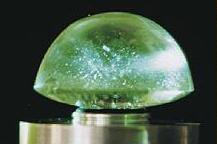 The
Vikings could have been using a telescope hundreds of years
before Dutch spectacle makers supposedly invented the device in
the late 16th century. The
Vikings could have been using a telescope hundreds of years
before Dutch spectacle makers supposedly invented the device in
the late 16th century.
This remarkable possibility has emerged
from a study of sophisticated lenses just recognised from a
Viking site on the island of Gotland in the Baltic Sea.
"It seems
that the elliptical lens design was invented much earlier that
we thought and then the knowledge was lost," says Dr Olaf
Schmidt, of Aalen University in Germany.
"The surface of some of the lenses have an
almost perfect elliptical shape," Dr Schmidt said. "They were
obviously made on a turning lathe."
But it seems clear that the Vikings did
not make the lenses themselves. "There are hints that the lenses
may have been manufactured in [the ancient empire of]
Byzantium or in the region of Eastern Europe," Dr
Schmidt said.
Some of the lenses can be seen at
Gotland's Fornsal, the historical museum in Visby. Some are in
the Swedish National Museum in Stockholm. Others have been lost.
(Link
to Full Article)
Greek Lenses:
Aristophanes in
The clouds (420 BC) describes the light focus effect of a lens:
STREPSIADES:
Have you ever seen a beautiful, transparent stone at the
druggists', with which you may kindle fire?
SOCRATES: You mean a crystal lens.
STREPSIADES: That's right. Well, now if I placed myself
with this stone in the sun and a long way off from the clerk,
while he was writing out the conviction, I could make all the
wax, upon which the words were written, melt.
Two
lenses of optical quality are on display at the Heraklion Museum of
ancient Cretan civilization. As many as fifty were reported as
having been found in the excavations of Troy, though only a handful
have been properly published. Some lenses from these sites have
impressive magnifying powers. One lens, probably of the fifth
century B.C., found in Crete, can magnify with perfect clarity up to
seven times. If it is held farther away from the object viewed, it
will actually magnify up to twenty times, though with considerable
distortion. (4)
Babylonian Lenses:
Their long line of
astronomical records on clay tablets stored in the British Museum,
dating back to 747 B.C., indicate they observed some of the moons of
Jupiter and Saturn. �There is said to be distinct evidence that
they observed the four satellites of Jupiter, and strong reason to
believe that they were acquainted likewise with the seven satellites
of Saturn,� wrote the English Orientalist George Rawlinson, in the
1860�s. �It has generally been assumed that they were wholly
ignorant of the telescope,� added this Camden professor of ancient
history. �But if the satellites of Saturn are really mentioned, as
it is thought that they are, upon some of the tablets, it will
follow�strange as it may seem to us�that the Babylonians probably
possessed optical instruments of the nature of telescopes, since it
is impossible, even in the clear vapourless sky of Chaldea [ancient
Babylonia], to discern the faint moons of that distant planet
without lenses.�
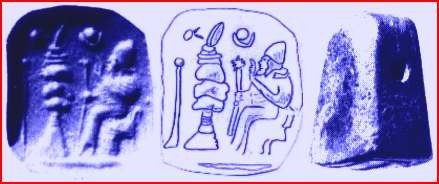
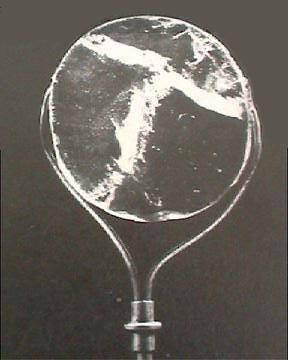
The Layard (Nineveh) Lens
- 721 - 705 B.C.
The Nineveh Lens: This 3,000 year old piece of rock-crystal was
unearthed in 1853 from the throne room of King Sargon II's Assyrian
palace of Nimrud, in Nineveh (Kuyunjik, Iraq).
Layard discovered this lens (right) which is considered the
first used (or found) plano-convex lens. This lens however was not
"ground" and polished round but had facets which limited it's
ability to magnify. It has been said that this lens could actually
have been only an ornament or menagerie. The reproduction shown here
shows both a horizontal and straight view.
On display at the
British Museum.
Egyptian Lenses:
There are several
examples of early lenses appearing fully formed about 2600-2575 B.C.
At Meidum in the famous statues of Rahotep and his wife Nofret and
reappear sporadically in small statuary throughout the Fourth and
Fifth Dynasties. The peak of development of these lenses was reached
circa 2475 B.C.E. The last Old Kingdom example being that of Mitri.
Another Fifth Dynasty statue, that of the funerary Priest Kaemked,
had eye structures where the rock crystal lenses were replaced with
obsidian, a dark volcanic glass. In the Sixth Dynasty, there are no
known examples of these eye structures.
(5)
The composition of
these eyes is a lens of polished rock crystal (either alpha silica
or fused silica, formerly known as cystalline quartz and fused
quartz which had a convex front surface and a near hemispherical
concave ground pupil surface in a flat iris plane (normally covered
with resin) at the rear of the lens. The white of the eye (the
sclera) was carved/ground in white limestone, cloudy or translucent
quartz, or marble, some of the latter contained impurities which
simulate the conjunctive capillaries of the eye
The early examples
of Nofret and Rahotep have well developed pupillary structures with
thick lenses and a point as part of the pupillary concave ground
rear lens, as did the reserve eye E-3009. The ka statue of King Hor
has a ring in that ground surface instead of a point and the lens
seems not as clear. Dr. Enoch noted that Late Period lenses found by
Flinders Petrie at Tanis are simply not in the same class as these
much earlier examples. The grinding and polishing of these eye
lenses appear to be done in pairs, perhaps from the same larger
crystal,
Dr. Enoch noted
that the quality of these eyes clearly indicates that these could
not have been �first attempts� and must represent a development from
earlier models which are lost or await discovery.
(5)
(Crystals)
(Prehistoric
Sciences)
(Anomalous
Artefacts)
|
 The Nimrud lens: Whatever its origin, as
ornament, as magnifying lens or part of a telescope, the Nimrud
lens is the oldest lens in the world. Looking at it evokes
mystery and wonder. It can be seen in room 55 of the British
Museum, in case 9 of the Lower Mesopotamian Gallery. However
unusual this object seems at first, it is not unique. In fact
there are several hundred reported lenses now on record from
around the ancient world.
The Nimrud lens: Whatever its origin, as
ornament, as magnifying lens or part of a telescope, the Nimrud
lens is the oldest lens in the world. Looking at it evokes
mystery and wonder. It can be seen in room 55 of the British
Museum, in case 9 of the Lower Mesopotamian Gallery. However
unusual this object seems at first, it is not unique. In fact
there are several hundred reported lenses now on record from
around the ancient world. These
ancient lenses generally magnify about 1.5 or 2 times. Heinrich
Schliemann (left), the 19th century discoverer of Troy,
excavated 48 rock crystal lenses at Troy. This is one of the
largest hoards of ancient lenses ever found. These were
unfortunately lost for many decades because they were with the
missing Trojan gold hoard which disappeared from the Berlin
Museum at the end of the Second World War. In recent years the
Russians have admitted that the Red Army stole the gold and it
is all in Moscow today. The 48 lenses are with these gold
artefacts.
These
ancient lenses generally magnify about 1.5 or 2 times. Heinrich
Schliemann (left), the 19th century discoverer of Troy,
excavated 48 rock crystal lenses at Troy. This is one of the
largest hoards of ancient lenses ever found. These were
unfortunately lost for many decades because they were with the
missing Trojan gold hoard which disappeared from the Berlin
Museum at the end of the Second World War. In recent years the
Russians have admitted that the Red Army stole the gold and it
is all in Moscow today. The 48 lenses are with these gold
artefacts. The
Vikings could have been using a telescope hundreds of years
before Dutch spectacle makers supposedly invented the device in
the late 16th century.
The
Vikings could have been using a telescope hundreds of years
before Dutch spectacle makers supposedly invented the device in
the late 16th century. 